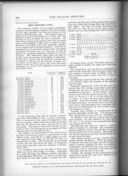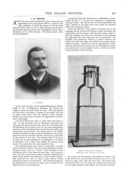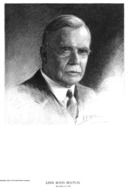For Northwestern Type Foundry (Benton, Waldo) and then American Type Founders.
The definitive biographical study of Linn Boyd Benton (and son Morris Fuller Benton, who was without question the most important type designer of the Twentieth Century) is Patricia Cost's book The Bentons: How an American Father and Son Changed the Printing Industry (Rochester, NY: RIT Cary Graphic Arts Press, 2011). See also her website/blog at www.morrisbenton.com/
Benton's work is discussed on CircuitousRoot in these Notebooks:

"Self Spacing Type" (1886)
"Self Spacing Type." The Inland Printer. Vol. 4, No. 3 (1886-12): 180. Although this piece is written as if it were an article, it is in fact an advertisement which appeared in the section of type display advertisements. It is itself set in Long Primer Old Style No. 24 and Brevier Old Style No. 22. These names emphasize an interesting historical fact: that while Benton's "self spacing" type was rationalized set-wise it was pre-point-system.
Scanned by my from an original.

The Building of a Book (1906)
Hitchcock, Frederick H. The Building of a Book. (NY: The Grafton Press, 1906). Linn Boyd Benton wrote the chapter on "The Making of Type," pp. 31-40. It is not illustrated, it is too brief, and it (the chapter, not the book as a whole) describes ATF's method of this period as if it is the only method by which type is made - but it is Benton speaking here for himself, and that makes it worthwhile.
This book has been digitized several times, and copies are available online from The Internet Archive, The Hathi Trust, and Google Books. The link here is to a local copy of the digization of the Univ. of California copy from The Internet Archive. It is to a PDF version. Here's the much nicer DJVU version . (These local copies are actually in the Notebook on the General Literature on Making Printing Matrices and Types .)

In The Inland Printer (1893)
Anon. "L. B. Benton." The Inland Printer. Vol. 11, No. 3 (1893-06): 237-238. This is a brief biographical sketch, with a portrait and an illustration of the punch-cutting version of Benton's vertical pantograph. It is important because it describes briefly the overall method of punch engraving, and in doing so confirms that the method of electroforming over cut wax plates was in use at this relatively early date.
Digitized by Google from the University of Michigan copy and available via The Hathi Trust. The PDF linked here is assmbled from Hathi Trust page images. Hathi ID: mdp.39015086781211

Bullen in The Inland Printer (1922)
Bullen, Henry Lewis. "Linn Boyd Benton - The Man and His Work." The Inland Printer, Vol. 70, No. 1 (October, 1922): frontis, pp. 60-64.
This is an important source both for Benton and for ATF matrix making methods. It must be treated with great caution, however, as Bullen is not a reliable source. In this article, his discussion of Ottmar Mergenthaler's involvement with the Linotype is inaccurate, his story of the evolution of Benton's pantograph into a punch-cutting machine cannot be correct, and his story of the reasons for Benton's original development of a pantograph engraver, even if true, is misleading. These errors cast doubt upon the entire article.
See Bullen on Mergenthaler (1922) for an analysis of the errors in his sketch of Ottmar Mergenthaler and the development of the Linotype. His account is both wrong and mean-spirited.
See Benton's Vertical Pantograph for Patrices and Punches for an analysis of the problems with Bullen's story of the influence of the Linotype on Benton's engraving machines. The story Bullen tells has often been repeated, but it cannot be true.
Bullen's story of the reasons for Benton's original development of a pantograph engraver is, even if true, quite misleading. See the Notebooks on Benton's Vertical Pantograph for Patrices and Patrix Cutting and Matrix Electroforming for analyses of this.
This volume of The Inland Printer has been digitized by Google from the University of Michigan copy and is available via The Hathi Trust (Hathi ID: mdp.39015086783449). The icon at left links to a local copy of an extract of just the Bullen article on Benton.

Obituary, Inland Printer (1932)
Anon. "Achievements of Linn Boyd Benton Vital to Industry's Progress." The Inland Printer, Vol. 89, No. 5 (August, 1932): frontis, pp. 53-54. Photographed by DMM from the University of Wisconsin copy.
This obituary is anonymous. It cites Bullen's writings on Benton, and quotes freely from them, but to the extent that it does so it is unreliable. The story it tells of the interaction between the Mergenthaler company and Benton with regard to Benton's pantograph is clearly based on earlier accounts by Bullen. But as it is inaccurate even beyond Bullen's previous (inaccurate) stories (it claims that the Mergenthaler company acquired the right to sell Benton engraving machines, and did so) it is probably filtered through a writer even less well acquainted with the facts.
Benton was a man of genius who devoted much of his life to the elimination of even minute error. He deserved an obiturary which would have lived up to these ideals.
The material from The Inland Printer reprinted here, whether digitized by Google or myself, is in the public domain due either to the failure to renew copyright as then required or to that plus the expiration of all possible copyright. The digitizations here remain in the public domain.
Hitchcock's The Building of a Book is in the public domain, as are the Internet Archive and Hathi/Google versions. The sections of it reprinted here remain in the public domain.
All portions of this document not noted otherwise are Copyright © 2008, 2011-2013, 2022 by David M. MacMillan.
Circuitous Root is a Registered Trademark of David M. MacMillan.
This work is licensed under the Creative Commons "Attribution - ShareAlike" license, version 4.0 International. See http://creativecommons.org/licenses/by-sa/4.0/ for its terms.
Presented originally by Circuitous Root®